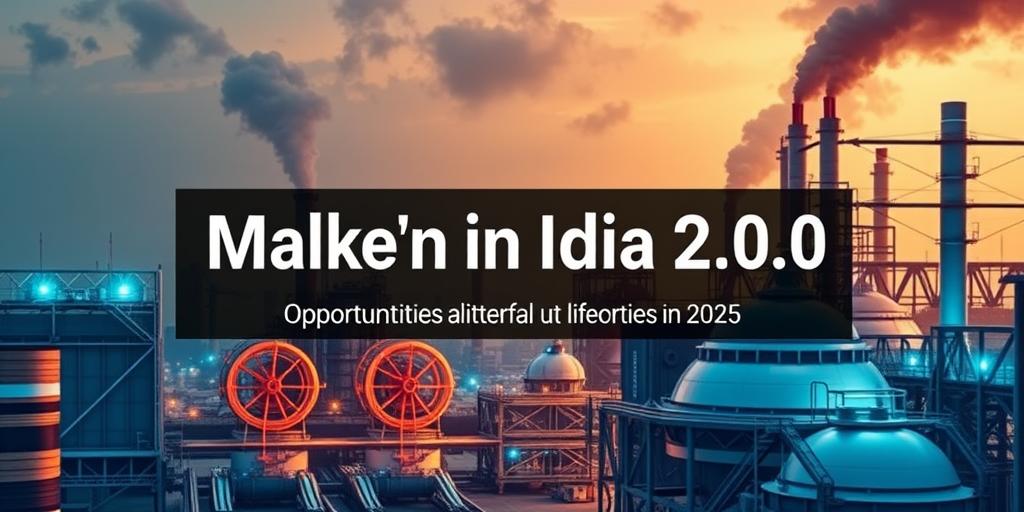Make in India 2.0: Opportunities and Realities in 2025
The “Make in India” initiative, launched in 2014, aimed to transform India into a global manufacturing hub. As we approach 2025, it’s crucial to assess the program’s progress, identify emerging opportunities, and acknowledge the persistent challenges.
Progress and Achievements
- Increased FDI: The initiative has attracted significant Foreign Direct Investment (FDI) in key sectors like electronics, automotive, and pharmaceuticals.
- Manufacturing Growth: India’s manufacturing sector has witnessed moderate growth, contributing to the country’s GDP.
- Policy Reforms: The government has introduced several policy reforms, including tax incentives and simplified regulatory processes, to promote manufacturing.
Emerging Opportunities
- Global Supply Chain Diversification: The COVID-19 pandemic has accelerated the trend of global supply chain diversification, presenting an opportunity for India to become a preferred manufacturing destination.
- Digital Manufacturing: The adoption of technologies like AI, IoT, and 3D printing is transforming manufacturing processes, creating opportunities for India to leapfrog traditional manufacturing models. (Long-tail keyword: digital manufacturing India)
- Green Manufacturing: With increasing global focus on sustainability, there is a growing demand for green manufacturing practices, which India can leverage to gain a competitive advantage. (Long-tail keyword: sustainable manufacturing in India)
- Focus on R&D and Innovation: Encouraging research and development can help in creating innovative products and processes. This will, in turn, lead to higher value addition and technological advancement within the manufacturing sector.
- Skilled Workforce Development: Investments in education and training programs to create a skilled workforce that meets the demands of modern manufacturing industries is crucial.
Persistent Challenges
- Infrastructure Deficits: Inadequate infrastructure, including transportation, power, and logistics, remains a major bottleneck for manufacturing growth.
- Regulatory Hurdles: Complex regulatory procedures and bureaucratic delays continue to impede investment and operations.
- Skill Gaps: A shortage of skilled labor and technical expertise poses a challenge to the adoption of advanced manufacturing technologies. (Long-tail keyword: India manufacturing skills gap)
- Land Acquisition Issues: Delays in land acquisition for manufacturing plants and infrastructure projects often lead to project delays and increased costs.
- Trade Barriers and Competition: Navigating international trade barriers and competition from other manufacturing hubs like China and Vietnam remains a challenge.
Make in India 2.0
The government has launched Make in India 2.0 to address these challenges and further enhance the program’s effectiveness. Key focus areas include:
- Promoting sunrise sectors: Identifying and supporting emerging sectors with high growth potential.
- Enhancing infrastructure: Investing in infrastructure development to improve connectivity and reduce logistics costs.
- Simplifying regulations: Streamlining regulatory processes and reducing compliance burden.
- Investing in skill development: Providing training and skill development programs to create a skilled workforce. (Long-tail keyword: skill development programs India)
The Reality in 2025
By 2025, India has the potential to emerge as a significant player in the global manufacturing landscape. However, realizing this potential requires concerted efforts from the government, industry, and academia to address the challenges and capitalize on the opportunities. (Long-tail keyword: India global manufacturing 2025)
The success of Make in India 2.0 will depend on:
- Effective Implementation: Ensuring timely and effective implementation of policy reforms.
- Collaboration: Fostering collaboration between government, industry, and academia.
- Innovation: Promoting innovation and adoption of advanced manufacturing technologies.
Conclusion
Make in India 2.0 presents a promising pathway for India to strengthen its manufacturing capabilities and achieve its economic goals. By addressing the challenges and seizing the opportunities, India can transform itself into a competitive and sustainable manufacturing hub by 2025.
